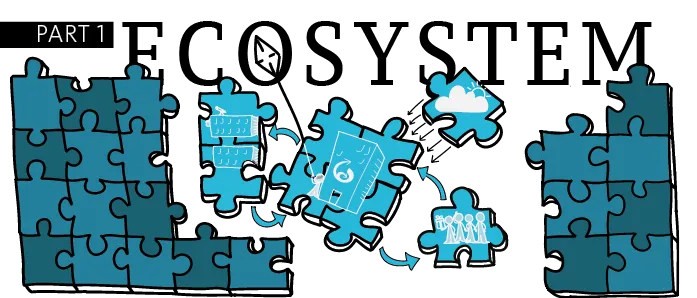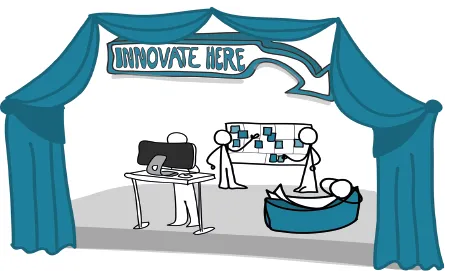![]()
Part 1 Ecosystem
![]()
ECOSYSTEM
[ek-oh-sis-tuh m, ee-koh-]
A system, or a group of interconnected elements, formed by the interaction of a community of organisms with their environment.
Any system or network of interconnecting and interacting parts, as in a business.
In order to succeed at innovation, established companies do not have to act like startups. Every startup’s aspiration is to become a successful company! So, abandoning business model execution practices and applying searching methods on an already successful business model is a form of waste. We strongly believe that operational excellence is still an important management practice, even in times of rampant disruption. Our cash cow products are how we get the money to invest in innovation.
The challenge comes when companies act as if they are single institutions with a single business model. If they view themselves this way, then the false choice of acting or not acting like a startup becomes ‘real’. The best way to innovate is for a large company to view itself as an innovation ecosystem with various products, services and business models. A company can then apply the right management tools to products that have validated business models versus those that are still in search mode.
This is how a company becomes an ambidextrous organization that is, in practice, excellent at both searching and executing. The chapters in this section describe the core principles for building innovation ecosystems.
‘Innovation has nothing to do with how many R&D dollars you have… It’s about the people you have, how you’re led and how much you get it.’
Steve Jobs, Founder and former CEO of Apple
![]()
CHAPTER ONE
Innovation Ecosystem
Most senior executives can relate. It usually starts with some startup types within the company telling them scary stories about how startups are coming to eat their lunch. Look at Facebook, Uber, Twitter and Airbnb! Oh, look what happened to Blockbuster, don’t let that happen here. Do you know Nokia used to be the largest mobile phone company in the world? Now look at them! We need to innovate like startups! We need to set up an incubator, an accelerator and put more money into R&D.
While there is often agreement that there should be more investment in innovation, the debate is always about where and how those investments should be made. Depending on who they talk to, corporate leaders will often get conflicting advice. Should innovation units be physically separated from the main business, or can innovation be managed within the same company? This is a sensible discussion to have. But much of the advice that leaders get is filled with polemics.
Each side takes an extreme view. One commonly cited problem is that traditional managers with MBAs are too stuck in their ways to understand innovation. These managers are also incentivized to behave in a manner that stifles innovation. People cannot get any innovation done within a company that expects a thirty page business case before it funds any idea. Ultimately, such a company will always invest in sure bets; which means that the company always works on the same types of products.
This is indeed a challenge. But it is equally true that setting up separate innovation labs does not guarantee that any successful products will emerge from there. For the most part these are places where innovation theater takes place. Look-a-here! We are doing lean startup, design thinking, customer development, business model canvas and minimum viable products… Sure. Whatever. None of these techniques in themselves represent innovation. The ultimate measure of success is the development of new products with sustainably profitable business models.
Why Innovation Fails
Such polemical debates fail to get at the core of why innovation in established companies succeeds or fails. Ultimately, innovation fails when a large company decides to use the same processes it uses to manage its core products to manage its innovation projects. Business planning does not work for innovation. All estimates of ROI, NPV and ARR are fiction. Investments based on such numbers are usually bets made on faith. As already noted, this approach also encourages managers to develop a tendency to invest in ‘surebet’ products for current markets.
The feeling is that by creating innovation labs, managers can separate innovators from the toxic environment within the company. But these labs fail because companies do not build any management processes around them, allowing innovators to work on whatever they want. There is a common tendency to conflate creat...



